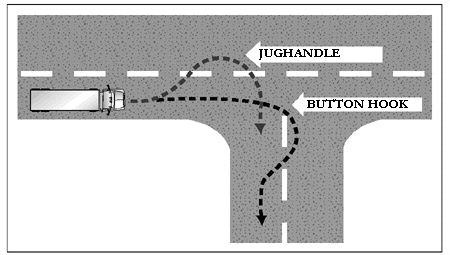True/False
Indicate whether the
statement is true or false.
|
|
|
1.
|
A combination vehicle is usually heavier, longer and requires more driving skill
than a single commercial vehicle.
|
|
|
2.
|
More than half of all truck driver deaths in crashes are the result of truck
rollovers.
|
|
|
3.
|
In a combination vehicle, the “crack-the-whip” effect describes how
the motion of a quick lane change can turn the trailer over.
|
|
|
4.
|
Large combination vehicles take less time and distance to stop when they are
empty than when they are fully loaded since there is less weight.
|
|
|
5.
|
Clearance underneath a combination vehicle is not a problem when crossing a
railroad crossing.
|
|
|
6.
|
When you back a trailer in a curved path, it is always safest to position your
vehicle so you can back to the driver’s side and not the passenger’s side.
|
|
|
7.
|
When backing a trailer, you turn the top of the steering wheel in the opposite
direction that you want the trailer to go.
|
|
|
8.
|
To help prevent a rollover, keep loaded cargo as close to the ground as you
can.
|
|
|
9.
|
A tractor bobtailing (driving with no trailer) takes longer to stop than a
loaded tractor-trailer.
|
|
|
10.
|
Trailer hand valves should be used during normal vehicle operation in order to
slow or stop the vehicle.
|
Multiple Choice
Identify the
choice that best completes the statement or answers the question.
|
|
|
11.
|
Which of the following are considered a “combination
vehicle”?
a. | Tractor-trailer. | b. | Double trailer. | c. | Triple
trailer. | d. | Straight truck with a trailer. | e. | All of the
above. |
|
|
|
12.
|
There are two important things to keep in mind to prevent rollovers. One
is to keep the cargo as low to the ground as possible. What is the other?
a. | Make sure the fifth wheel is adjusted properly. | b. | Use stab braking
during a turn. | c. | Drive slowly around turns. | d. | Tighten air brake free
play. |
|
|
|
13.
|
When a tractor pulling a double trailer makes a quick lane change, what part of
the vehicle is more likely to turn over?
a. | The tractor. | b. | The front trailer. | c. | The rear
trailer. |
|
|
|
14.
|
When the wheels of a trailer lock up, the trailer can swing out in a
“trailer jackknife.” If you can, the best course of action is to:
a. | Use the trailer hand brake if you have one. | b. | Downshift
quickly. | c. | Turn in the direction the trailer is skidding. | d. | Release the brakes
to get traction back on the trailer wheels. |
|
|
|
15.
|
What is offtracking?
a. | When the steering wheel is turned at a different rate than the front
wheels. | b. | When a combination vehicle goes around a corner, the rear wheels follow a different
path than the front wheels. | c. | When the fifth wheel turns at a slower rate
than the steering wheel. | d. | When the tractor and trailer are in different
positions. |
|
|
|
16.
|
Which of the following are good basic backing rules:
a. | Look at your path before you begin. | b. | Use mirrors on both sides. | c. | Back
slowly. | d. | Correct drift immediately. | e. | All of the
above. |
|
|
|
17.
|
Which of the following trailers can get stuck on a railroad-highway
crossing?
a. | Lowboy. | b. | Car carrier. | c. | Moving
van. | d. | All of the above. |
|
|
|
18.
|
What is the correct method for making a right hand turn if you cannot make the
turn without crossing into another lane? Refer to the diagram, below:  a. | Button Hook. | b. | Jug Handle. | c. | Both are
correct. | d. | Neither are correct. |
|
|
|
19.
|
What does the trailer hand valve do?
a. | Releases the tractor hand brake. | b. | Works the trailer
brakes. | c. | Locks all brakes on a tractor-trailer. | d. | Shuts off the air
compressor. |
|
|
|
20.
|
When should you use the trailer hand valve to park a combination
vehicle?
a. | To park at a loading dock. | b. | When the load is
overweight. | c. | To park on a hill or grade. | d. | Never. |
|